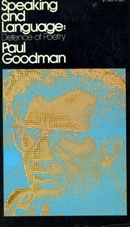
Speaking and Language
Defence of Poetry
Goodman, Paul
Publisher: Vintage, New York, USA
Year First Published: 1971
Year Published: 1972
Pages: 244pp Library of Congress Number: P106.G6 1972b Dewey: 418
Resource Type: Book
Cx Number: CX6578
Goodman writes, "I do not think there can be a rule for the appropriate use of formal or vernacular language...The best is to try for a vernacular that molds itself to what is going on and to use it critically".
Abstract:
Exploring language from various perspectives, this book is a modern study of linguistics. Goodman looks at spoken and written language from the point of view of anthropologists, theorists of communications, philologists and other scientific linguists. He uncovers the connection between articulate speech and eloquent writing. In a fresh view of linguistics, he claims that different reactions occur when a person chooses to speak or not speak. Choosing to speak to another person establishes a connection and the recognition of a human relationship. He also provides explanations of other linguistic perspectives on such matters.
Speaking and Language is divided into two sections. Part 1: Language explains Goodman's linguistic theories and their relation to the history of scientific linguistics, and focuses on spoken and unspoken language. Part 2: Literature describes the structural rules of written language and the writing process. Critiques of several programs attempting to reconstruct language with more consistent rules can also be found in this section. Such programs include positivism, Basic English, structuralism and literary grammar. Goodman takes the position that language ought not to be reconstructed.
This book is an examination of language, not an attempt to perfect it. Goodman analyzes the attempts to reconstruct language, but contends that there are no universal rules in the English language for a reason. The visible rules are interesting to explore but always have exceptions, and this should not be changed by "cleaning up" or simplifying language. Goodman writes, "I do not think there can be a rule for the appropriate use of formal or vernacular language...The best is to try for a vernacular that molds itself to what is going on and to use it critically". Language should be flexible yet consistent. It should have a natural structure, but retain its plasticity for creative use. In short, language is already near-perfect.
[Abstract by Mia Manns]
Table of Contents
Part I: Language
1. Not Speaking and Speaking
2. Speaking as an Action, Speech as a Thing
3. Speaking and Language
4. Sub-Languages
5. Speaking as a Unique Kind of Experience
6. Some Reflections on Scientific Linguistics
Part II: Literature
7. Constructed Languages
8. Complex Words and Poetry
9. Literary Process
10. Literary Style as Hypothesis
11. Format and "Communications"
12. Notes for a Defence of Poetry
Subject Headings


